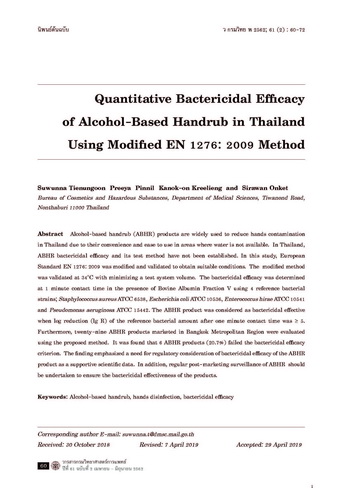ประสิทธิภาพเชิงปริมาณในการฆ่าเชื้อแบคทีเรียของเจลทามือในประเทศไทย ชนิดที่มีแอลกอฮอล์เป็นส่วนประกอบ เมื่อทดสอบด้วย Modified EN 1276: 2009 method
คำสำคัญ:
Alcohol-based handrub, hands disinfection, bactericidal efficacyบทคัดย่อ
ผลิตภัณฑ์สำหรับรักษาสุขภาพอนามัยมือแบบพร้อมใช้ ที่มีแอลกอฮอล์เป็นส่วนประกอบหลัก (alcohol-based handrub-ABHR) เป็นที่นิยมอย่างแพร่หลายในประเทศไทย เนื่องจากความสะดวกและรวดเร็วในการใช้งานแม้ในบริเวณที่ไม่มีน้ำเพื่อลดปริมาณเชื้อก่อโรคซึ่งอาจส่งผ่านจากมือที่ปนเปื้อน อย่างไรก็ตาม ผลิตภัณฑ์ ABHR ที่วางจำหน่ายในประเทศไทยยังไม่มีการกำหนดเกณฑ์ประสิทธิภาพการฆ่าเชื้อรวมถึงวิธีทดสอบ จึงได้นำวิธีทดสอบสากล EN 1276: 2009 มาปรับให้เหมาะสมโดยทำการทดสอบที่อุณหภูมิ 34 องศาเซลเซียส และปรับลดการเจือจางในขั้นตอนทดสอบ ในสภาวะที่มี Bovine Albumin Fraction V ในเวลาทดสอบ 1 นาที โดยทดสอบกับเชื้อมาตรฐาน 4 ชนิด ได้แก่ Staphylococcus aureus ATCC 6538, Escherichia coli ATCC 10536, Enterococcus hirae ATCC 10541 และ Pseudomonas aeruginosa ATCC 15442 ผลิตภัณฑ์ที่สามารถลดปริมาณเชื้อได้ในเวลาสัมผัสเชื้อ 1 นาที ต้องมีค่า log reduction (lg R) ≥ 5 จากการประเมินคุณภาพผลิตภัณฑ์ ABHR ที่จำหน่ายในท้องตลาด จำนวน 29 ตัวอย่าง ด้วยวิธีที่ปรับใหม่นี้พบว่ามีตัวอย่างไม่ผ่านเกณฑ์ 6 ตัวอย่าง (ร้อยละ 20.7) แสดงให้เห็นว่าข้อมูลด้านประสิทธิภาพ ด้านการฆ่าเชื้อแบคทีเรียของผลิตภัณฑ์ ABHR เป็นข้อมูลที่จำเป็นเพื่อสนับสนุนการควบคุมคุณภาพและพิจารณากำหนดมาตรฐานผลิตภัณฑ์ ABHR ของประเทศ นอกจากนี้ควรมีการเฝ้าระวังคุณภาพหลังจำหน่ายเพื่อคุ้มครองผู้บริโภคและพัฒนาคุณภาพผลิตภัณฑ์ต่อไป
เอกสารอ้างอิง
World Health Organization. WHO guidelines on hand hygiene in health care: first global patient safety challenge clean care is safer care. [Online]. 2009 [cited 2018 Aug 11]; [270 screens]. Available from: URL: https://apps.who.int/iris/bitstream/handle/10665/44102/9789241597906_eng.pdf;jsessionid=797DC5A1EBB75963455DB4DE6A10AC04?sequence=1.
Boyce JM, Pittet D. Guideline for hand hygiene in health-care settings: recommendations of the healthcare infection control practices advisory committee and the HICPAC/SHEA/APIC/IDSA hand hygiene task force. MMWR. [Online]. 2002 [cited 2018 Mar 10]; 51(RR-16): 1-45. Available from: URL: https://www.cdc.gov/mmwr/preview/mmwrhtml/rr5116a1.htm.
Kilpatrick C, Hosie L. Storr J. Hand hygiene-when and how it should be done? Nurs Times. [Online]. 2013 [cited 2018 Mar 10]; 109: 16-8. Available from: URL: https://www.nursingtimes.net/Journals/2014/04/09/x/n/p/Hand-hygiene---when-and-how-should-it-be-done-250913.pdf.
Pratt RJ, Pellowe CM, Wilson JA, Loveday HP, Harper PJ, Jones SRLJ, et al. epic2: National evidence-based guidelines for preventing healthcare-associated infections in NHS hospitals in England. J Hosp Infect 2007; 65S: S1–S64.
Food and Drug Administration. Ingredients not listed in Ministry of Public Health Notification for Cosmetics. In: Criterion for determination of Cosmetic Notification. Nonthaburi, Thailand: Bureau of Controlled Cosmetics and Hazardous Substances, Food and Drug Administration; 2016.
Robinson AL, Lee HJ, Kwon J, Todd E, Rodriguez FP, Ryu D. Adequate hand washing and glove use are necessary to reduce cross-contamination from hands with high bacterial loads. J Food Prot 2016; 79(2): 304-8.
Hammer KA, Carson CF, Riley TV. Influence of organic matter, cations and surfactants on the antimicrobial activity of Melaleuca alternifolia (tea tree) oil in vitro. J Appl Microbiol 1999; 86(3): 446-52.
Gaonkar TA, Geraldo I, Caraos L, Modak SM. An alcohol hand rub containing a synergistic combination of an emollient and preservatives: prolonged activity against transient pathogens. J Hosp Infect 2005; 59(1): 12-8.
EN 1276: 2009. Chemical disinfectants and antiseptics-Quantitative suspension test for the evaluation of bactericidal activity of chemical disinfectants and antiseptics used in food, industrial, domestic, and institutional areas-Test method and requirements (phase 2, step 1). Brussels, Belgium: European Committee for Standardization; 2009.
EN 14885: 2015. Chemical disinfectants and antiseptics-Application of European Standards for chemical disinfectants and antiseptics. Brussels, Belgium: European Committee for Standardization; 2015.
Messager S, Hammer KA, Carson CF, Riley TV. Assessment of the antibacterial activity of tea tree oil using the European EN 1276 and En 12054 standard suspension tests. J Hospital Infection 2005; 59(2): 113-25.
Taylor JH, Rogers SJ, Holah JT. A comparison of the bactericidal efficacy of 18 disinfectants used in the food industry against Escherichia coli O157: H7 and Pseudomonas aeruginosa at 10 and 20๐C. J Appl Microbiol 1999; 87(5): 718-25.
Russell AD. Factors influencing the efficacy of antimicrobial agents. In: Russell AD, Hugo WB, Ayliffe GAJ, Editros. Principles and practices of disinfection, preservation, and sterilization. Oxford: Blackwell Scientific Publications; 1982.
Russell AD. Bacterial resistance to disinfectants. J Infect Prevention 2002; 3(3): 22-4.
Langsrud S, Sundheim G. Factors influencing a suspension test method for antimicrobial activity of disinfectants. J Appl Microbiol 1998; 85(6): 1006-12.
Marsh A. Facts about your skin-temperatures in and on the human body. [Online]. 2012 [cited 2018 Mar 10]; [4 screens]. Available from: URL: https://www.healthyheating.com/Definitions/facts_about_skin.htm.
Farzana A. Temperature of A healthy human (skin temperature). [Online]. 2001 [cited 2018 Mar 10]; Available from: URL: https://hypertextbook.com/facts/2001/AbantyFarzana.shtml.
Bierman W. The temperature of the skin surface. JAMA 1936; 106(14): 1158-62.
United States Pharmacopoeia and National Formulary (USP 41-NF 36). Chapter 1072 Disinfectants and antiseptics. Volume 2. Rockville, Md: United States Pharmacopeial Convention, Inc; 2018. p. 7090-7095.
ISO 11930: 2019. Cosmetics-microbiology-evaluation of the antimicrobial protection of a cosmetic product. Geneva: International Organization for Standardization; 2019.
EN 1500: 2013. Chemical disinfectants and antiseptics-Hygienic handrub-Test method and requirements (phase 2, step 2). Brussels, Belgium: European Committee for Standardization; 2013.
ASTM E2276-10: Standard test Method for determining the bacteria-eliminating effectiveness of hygienic handwash and handrub agents using the fingerpads of adults. West Conshohochen, PA.: ASTM International; 2019.
Sutton SV, Proud DW, Rachui S, Brannan DK. Validation of microbial recovery from disinfectants. PDA J Pharm Sci and Technol 2002; 56(5): 255-66.
Ochwoto M, Muita L, Talaam K, Wanjala C, Ogeto F, Wachira F, et al. Anti-bacterial efficacy of alcoholic hand rubs in the Kenyan market, 2015. Antimicrob Resist Infect Control 2017; 6: 17. (6 p).
Ali Y, Dolan MJ, Fendler EJ, Larsoon EL. Chapter 12 Alcohols. In: Block SS. Disinfection, sterilization, and preservation. 5th ed. Philadelphia, PA: Lippincott Williams & Wilkins; 2001.
Guilhermetti M, Marques Wiirzler LA, Castanheira Facio B, da Silva Furlan M, Campo Meschial W, Bronharo Tognim MC, et al. Antimicrobial efficacy of alcohol-based hand gels. J Hosp Infect 2010; 74(3): 219-24.
do Prado MF, Coelho AC, de Brito JP, Ferreira DO, Junior AW, Menecucci Cda S, et al. Antimicrobial efficacy of alcohol-based hand gels with a 30-s application. Lett Appl Microbiol 2012; 54(6): 564-7.
U.S. Food and Drug Administration. FDA requests additional information to address data gaps for consumer hand sanitizers. [Online]. 2016 Available from: URL: https://www.fda.gov/news-events/press-announcements/fda-requests-additional-information-address-data-gaps-consumer-handsanitizers.
Safety and effectiveness of consumer antiseptics; topical antimicrobial drug products for over-thecounter human use; proposed amendment of the tentative final monograph; reopening of administrative record. [Online]. 2016 [cited 2019 Mar 10]; [26 screens]. Available from: URL: https://www.govinfo.gov/content/pkg/FR-2016-06-30/pdf/2016-15410.pdf
Kampf G, Hollingsworth A. Validity of the four European test strains of prEN 12054 for the determination of comprehensive bactericidal activity of an alcohol-base hand rub. J Hosp Infect 2003; 55(3): 226-31.
Senior H, Booth CM, Beswick A. A review of the data on efficacy of hand cleaning products in industrial use as alternatives to handwashing. [Online]. 2014 [cited 2018 Mar 10]; [42 screens]. Available from: URL: https://www.hse.gov.uk/research/rrpdf/rr1007.pdf.




